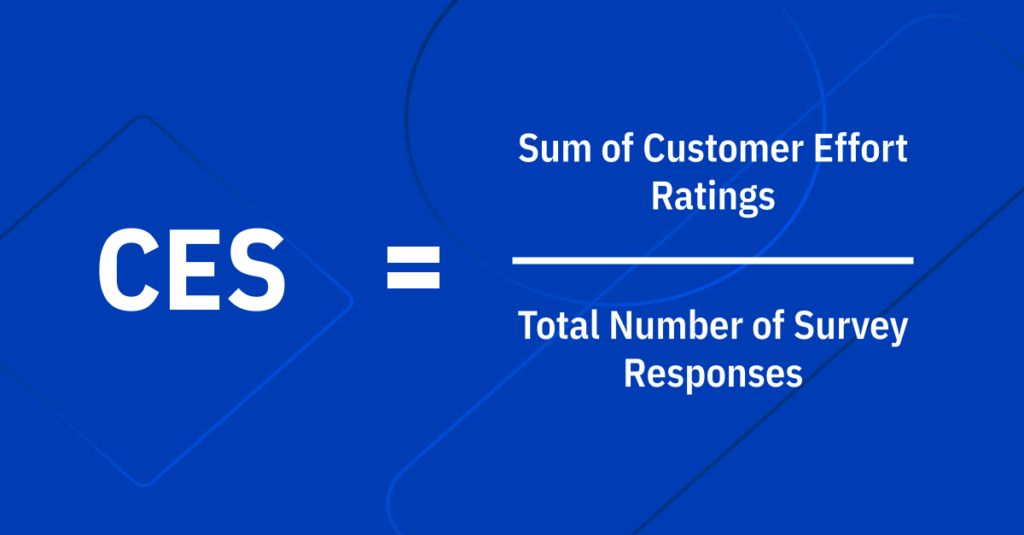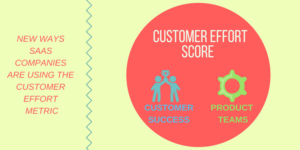Customer Effort Score (CES) is an index used to measure how much effort customers have put into their experiences and interactions with your company. Customers respond to a CES survey designed on a 5- or 7-point scale (with a few other variations). The higher the CES, the better. Companies that provide effortless service get higher scores, while companies that make it difficult for customers to deal with their products and services get lower scores.
Introduction to Customer Effort Score
Consumers today are busy and prefer getting help on their own terms and without too much hassle. This is true especially when they’re dealing with service issues or a broken product. Making it simpler for your customers reduces their effort and makes their lives easier. This enhances their view of your brand and overall customer experience.
- Customers with a high-effort service interaction become more disloyal compared to just 9% who have a low-effort experience.
- 94% of those with low-effort interactions intend to repurchase compared to 4% of those experiencing high effort.
This is why customer-centric organizations need to measure Customer Effort Score (CES). A Customer Effort Score is a single-item metric that businesses use to measure the effort a customer has to exert to resolve issues, have their requests fulfilled, find answers to their questions, or return a purchase.
CES is a leading indicator of customer experience and helps companies understand how much effort customers have put into their interactions with a brand. Questions designed to measure CES usually are phrased like this: “Did the company make it easy for you to handle your issue?”, or “How much effort did you have to make for your request to be handled?”
The rating system of CES surveys usually consists of numbers ranging from 1 (strongly disagree) to 5 (strongly agree) or 1 to 7. Essentially, the CES survey provides a quantifiable measurement of the ease or difficulty of doing business with a company.
Benefits of Using CES Surveys
Implementing Customer Effort Score surveys can provide businesses with valuable insights, foster customer-centric strategies, and contribute to long-term customer satisfaction and loyalty. Measuring and understanding customer effort should also play a crucial role in shaping the integrated CX (integrated customer experience), influencing various aspects of how customers perceive and interact with your brand.
Improve Customer Satisfaction
CES is closely linked to customer satisfaction. A lower effort score generally indicates higher satisfaction, as customers find it easy to navigate, interact, or resolve issues with a company. By measuring CES, businesses can gauge how well they are meeting customer expectations.
Drive Customer Loyalty
Effortless experiences contribute to increased customer loyalty. When customers find it easy to do business with your company, they are more likely to remain loyal and continue their relationship with the brand. Reducing customer effort can also positively impact your customer retention rates.
Identify Pain Points in the Customer Journey
CES helps businesses identify specific pain points in the customer journey. By understanding where customers encounter difficulties or experience frustration, you can prioritize improvements in those areas, ultimately enhancing the overall customer experience.
Improve Operational Efficiency
Monitoring CES can lead to improvements in operational efficiency. By streamlining processes and reducing customer effort, companies can optimize their operations and provide a smoother experience, which may lead to cost savings and increased productivity. According to research, the cost to serve a customer decreases by 37% when going from a high to a low level of effort experience.
Gain Customer Insights
Analyzing CES data can provide valuable insights into customer preferences, behaviors, and expectations. This information can guide strategic decision-making, product development, customer experience improvement, and other business initiatives.
Enjoy the ROI of Effortless Experiences
The return of reducing customer effort can be compelling and makes your brand stand out in a sea of unaccommodating, not-very-helpful competitors. Based on research by Gartner, customers with a high-effort service interaction become more disloyal compared to just 9% who have a low-effort experience; those with low-effort interactions are also more likely to repurchase. On the other hand, 96% of customers going through a high level of effort are likely to churn vs. only 9% of those who went through an effortless experience.
History of Customer Effort Score
The Customer Effort Score is a customer experience metric that researchers at the Corporate Executive Board (CEB) consulting firm first introduced in 2010. They proposed that the traditional emphasis on exceeding customer expectations and providing delightful experiences might not be the most effective approach to customer loyalty. Instead, they asserted that reducing customer friction or effort is actually a better driver of loyalty than creating exceptional experiences at single customer touchpoints.
The core idea behind CES is that customer loyalty is more strongly influenced by how easy or difficult it is for customers to resolve their issues or achieve their goals with a company. The authors argued that companies should focus on reducing customer effort rather than solely trying to exceed expectations, as low-effort experiences were found to be more strongly correlated with customer loyalty.
The concept of CES was significantly boosted after the researchers published their findings in a 2010 Harvard Business Review article where they wrote, “Our research shows that loyalty has a lot more to do with how well companies deliver on their basic, even plain-vanilla promises than on how dazzling the service experience might be.”
Different Types of CES Surveys
There are several different types of Customer Effort Score surveys to choose from, including:
Numbered Scales Survey
A numbered scale CES survey measures the level of effort a customer has to put in while interacting with a company. It does this by rating their interaction on a numbered scale, usually from 1 to 5 or 1 to 7.
The survey asks a simple question such as “How easy was it to solve your problem today?” and respondents rank their answer on the scale closer to one side (labeled as “very difficult”) or the other (labeled as “very easy”), depending on which side of the scale more closely indicates the ease of their customer service interaction.
Likert Scale Survey
The Likert scale is a commonly used psychometric scale that asks respondents to indicate their level of agreement or disagreement with a statement. If used for a CES survey, the Likert scale may ask customers to rate their level of agreement with a statement such as “It was easy to solve my problem today” on a scale ranging from “Strongly Disagree” to “Strongly Agree.”
Emotion Rating Survey
An emotion ratings CES survey measures the level of positive or negative emotions customers experience while interacting with a brand. This type of survey asks questions like “How happy did you feel while interacting with our company?” or “How frustrated did you feel while using our product?”
Customers rate their answers on a scale ranging from “Not at all” to “Very Much.” Emotion ratings CES surveys may also use emoticons or emojis, where respondents can select emojis — ranging from sad or angry faces, through neutral faces, to happy faces — to indicate how they felt about the ease of their customer experience.
Examples of CES Survey Questions
The most important part of your CES survey is the set of questions it contains. You’ll want to keep your questions simple and clear to get the most effective data. Most of your questions will have answers based on scales and may sound something like:
- “On a scale of 1-5, how quickly were you able to solve your problem?”
How you’ll choose the format and phrase your questions will depend on the type of survey you choose to use — for instance, a Likert scale CES survey will phrase questions as statements that the respondent will then choose to agree or disagree with, such as:
- “How much do you agree with the following statement: It was easy to find the information I needed on [name of company’s] website.”
Meanwhile, an emotion scale survey may contain questions like:
- “How knowledgeable do you feel [name of service rep] was?”
You may also want to add a few good clear yes-or-no questions that can be rated on any scale, like:
- “Were we able to meet your needs today?”
No matter what types of questions you are asking, you should avoid using the word “effort.” While the purpose of your CES survey is to measure customer effort, you’ll want to steer away from phrasing it so explicitly, as that can lead customers into giving the answers that you want rather than answers that accurately reflect their experience.
Customer Effort Score Calculation
Customer Effort Score is calculated by averaging all of the individual responses submitted through a CES survey question.
A company that provides effortless service gets a perfect 5 or 7 while a company that makes it difficult gets a 1. In other words, the higher the CES, the better.

InMoment’s default CES question template takes a similar approach and can be customized to fit your needs:

What is a Good Customer Effort Score (CES)?
A good Customer Effort Score is one that reflects a low level of effort on the part of the customer. The scale typically ranges from “very low effort” to “very high effort,” and the goal is to have a score that indicates minimal effort for customers to complete a specific task or interaction.
Poor scores (high effort) mean your customers faced significant challenges or frustrations. This could lead to dissatisfaction, increased customer churn, or negative word-of-mouth.
What constitutes a “good” CES can vary across industries and types of interactions. Additionally, comparing CES scores over time and against benchmarks within your industry can provide valuable insights. Regularly monitoring and analyzing CES data allows businesses to identify trends, make improvements, and enhance the overall customer experience.
When to Use Customer Effort Score
The three main customer experience KPIs include Net Promoter Score (NPS), Customer Satisfaction (CSAT), and Customer Effort Score (CES). CES can be used after any interaction a customer has with a company. It provides highly actionable information about your customers and is more accurate in predicting customer loyalty than CSAT. It is also often a great predictor of future purchase behavior and referrals.

Customer effort score is easy to deploy and track but does not always show the full picture of the customer’s relationships with the company. This is where NPS comes into play; the metric measures the whole relationship between the customer and the company. Meanwhile, CSAT is a similar short-term measure of a single interaction and allows for more versatility in the questions asked.
The Best Times to Send a CES Survey
A CES survey can be given immediately after an interaction that led to a purchase or subscription, immediately after an interaction with customer service or any service-related experience, and to supplement UI (user interface) and UX (user experience) testing for product teams.
Immediately After An Interaction that Led to a Purchase
Send the survey shortly after a customer completes a transaction, such as making a purchase or finishing a service request. You can also trigger CES surveys based on specific events or milestones in the customer journey, such as the completion of a trial period or the end of a subscription period.
Immediately After an Interaction with Customer Service
For certain touchpoints like customer support calls, online chat sessions, or help center tickets, sending the CES survey immediately after the interaction can capture the customer’s immediate feelings about the effort required.
To Supplement Product Teams User Testing
Product teams can integrate CES surveys directly into applications or websites for a seamless and timely feedback process. For example, you can trigger an in-app CES survey after a user completes a specific action or task.
How to Build a CES Survey
No matter what type of CES survey you choose, you’ll want to follow a few tips to ensure that the survey is effective at capturing your CES. You’ll likely want to:
Optimize for Mobile
Allow customers to take your survey on their phone or another mobile device. This increased convenience will allow more people to take your survey wherever they may happen to be.
Use Automation
Use or create an automated system that will record your customer’s answers and compile data from all respondents into a convenient report for you.
Keep It Simple
Avoid letting your CES survey get too long, or fewer people will be inclined to finish it. You’ll also want to avoid asking more complex questions with multiple parts.
Remember to apply the basic principles behind CES to your survey. The less effort it takes on the part of the customer to complete, the better.
How to Improve the CES Score at Your Company
Improving your company’s Customer Effort Score is an ongoing process that requires a commitment to customer-centricity, an integrated CX approach, and a willingness to adapt based on customer feedback and evolving trends. Regularly reassess your efforts and make adjustments as needed to ensure a seamless and low-effort customer experience.
Provide Multiple Channels for Contact/Feedback
Customers like to navigate multiple channels when interacting with your brand, so it’s important to make sure that you are able to meet and respond to their needs in these channels. Ensure that there are multiple options for them to share their unsolicited feedback. Map out the entire customer journey, highlighting key touchpoints where customers may encounter challenges or frustration.
Use Self-Service Tools
You can reduce friction and effort if customers can solve issues themselves without having to reach out to your team via phone, email, or help center. Chatbots, step-by-step tutorials and guides, FAQ sections, and help center articles are examples of self-service tools you can use. It’s also important to make sure that your websites, apps, and digital platforms have a user-friendly design, and that they’re optimized for mobile devices, in order to minimize navigation challenges.
Reduce Wait Times
When customers experience shorter wait times, whether it’s in a physical location, on the phone, or online, they perceive the interaction as more efficient and less burdensome. If you have long wait times, consider using a callback system or adding more staff during your busiest hours of operation.
How to Analyze and Act on CES Feedback
Acting on and analyzing Customer Effort Score involves a systematic approach to gathering insights, identifying areas for improvement, and implementing changes to enhance the customer experience.
Collect and Connect Feedback from Multiple Sources
Customers use a variety of channels to interact with your brand, such as your store, website, mobile app, contact center, social media, email, and so much more. Be sure you can collect and connect data from these channels and that they are analyzed within the context of the broader customer experience.
Consider a CX Platform
A customer experience management platform can help your team navigate and interpret CES feedback to understand where there is room for improvement and where you can deliver the highest impact for customers and your business. It’s important to choose a software solution that is scalable enough as your team receives an increasing number of survey responses. Another consideration to make is to have access to analytical tools that can automatically surface trends and insights from CES feedback, helping you take actionable steps toward reducing customer effort.
Respond to Your Customers
Interactions with extremely responsive companies feel easy and effortless. When distributing CES surveys, be sure you close the loop and acknowledge customers for sharing their feedback. If there are any high-impact issues affecting the customer experience, take steps to resolve them as soon as possible.
Set Up Automatic Alerts
Set up automatic alerts and continuously monitor your CES scores to track the impact of changes and improvements over time. Supplement your CES efforts with other customer experience metrics like Net Promoter Score (NPS) and Customer Satisfaction (CSAT) for a holistic view. Finally, ensure that everyone in the organization, from leadership to frontline employees, is committed to minimizing customer effort and delivering easier, more effortless experiences.
Improve Customer Effort Scores with InMoment
InMoment’s customer experience expertise helps businesses collect customer feedback and connect with customers in meaningful ways. Start improving your customer experiences today with InMoment. Schedule a CX demo to get more insight on how you can improve your customer effort score.
Sources:
Gartner. “What’s Your Customer Effort Score?” (https://www.gartner.com/smarterwithgartner/unveiling-the-new-and-improved-customer-effort-score). Access 12/16/2023.Harvard Business Review. “Stop Trying to Delight Your Customers” (https://hbr.org/2010/07/stop-trying-to-delight-your-customers). Access 12/17/2023.



